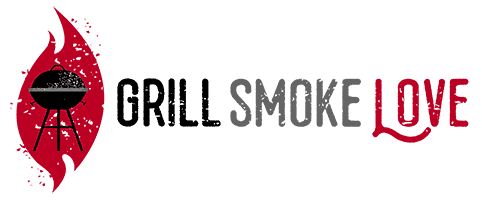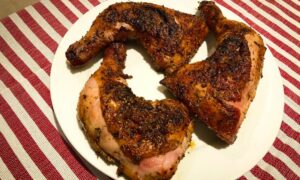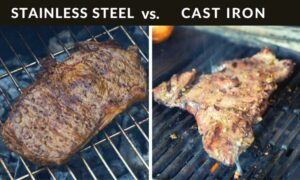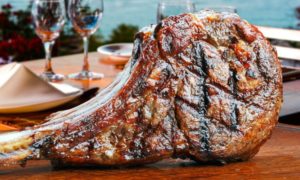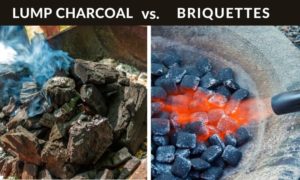We often conflate grilling with being outdoors and cooking on a backyard barbecue grill. Yet, grilling is a cooking technique, like roasting, frying, or sautéing, that can be accomplished anywhere with the right tools.
Indoor grilling allows you to enjoy healthy grilled foods year-round, and it’s a great option for people who live in condos that don’t allow gas grills.
But do you know how to grill indoors? Can it ever have the smokey flavors of real barbecue? And is it even safe?
Here’s a a complete with everything that you need to know about grilling indoors.
Grilling Indoors vs. Barbecue
Before we dive into looking at the hows and why of indoor grilling, it helps to step back and analyze what exactly grilling means to you.
There are many different forms of cooking, and grilling is a common one around the world. But people often associate grilling with barbeque, which is actually a sort of (delicious) regional cuisine.
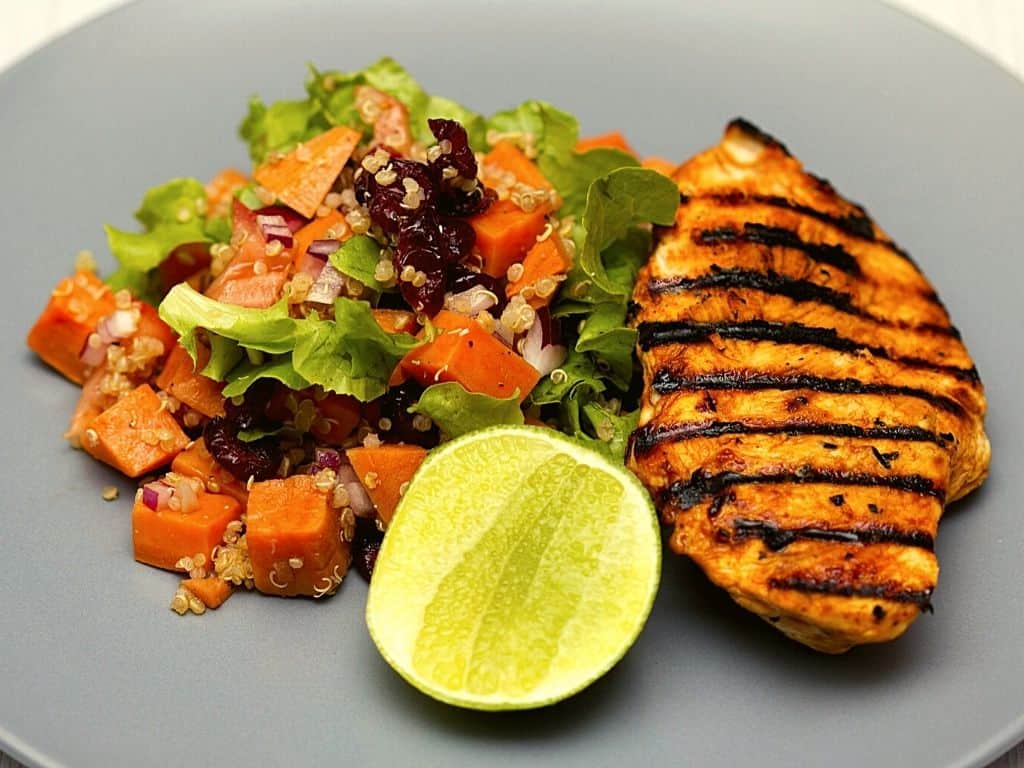
According to most definitions, grilling is a specialized type of broiling. I have a French-made oven which calls the broiler a “grill.” This is an important point to make because it means that you can grill food anywhere.
The primary thing that sets grilling apart from other cooking methods is that it means high and dry heat is applied to the food in a way that allows drippings to drain away.
Barbecue, on the other hand, is a complicated word. According to Dictionary.com, it can mean the open-air social gathering where food is being cooked, the act of grilling outside, or a specific type of dish served with a vinegar-based sauce.
To me, barbecue (the food, that is) is unique because it includes one ingredient that grilling often does not – smoke.
How Does Indoor Grilling Compare to Outdoor Grilling?
Most of us with gas grills are not, in my opinion, making barbecue. Occasionally, we set up our grills for something low and slow and smokey, but more often than not we crank up the grill and throw on steaks or burgers.
Our well-seasoned outdoor grills may imbue the slightest hint of smokiness into the food, but it’s generally not the prominent flavor note.
Indoor grilling means saying goodbye to real smoke.
We can come up with some ways to add that flavor, but it’s never going to compete with a charcoal-fired barbecue pit. However, it does give you the ability to enjoy grilled foods without using your gas or charcoal grill.
Why Grill Indoors?
You Can’t Use Outdoors Grill
For many people, the gas grill is a ubiquitous fixture on their back patio. But there are plenty of folks who just don’t have the option. They’d like to grill, but where they live precludes those beautiful stainless cooking appliances.
Apartment or condo bylaws, city ordinances, no access to gas, or unfavorable weather can all mean no grill for you.
Weather Conditions
Of course, even people who have grills don’t always want to use them. During the cold months, who wants to go outside and grill.
It takes a very committed individual, and a lot of propane, to dust off a few inches of snow and then get to grilling. No, most grills are stored in the garage or tucked under cover during the winter.
Even if you live in a tropical wonderland without snow, rainy days or buggy evenings can dampen your grilling excitement. In short, there are dozens of reasons why you might want to have access to some sort of indoor grill.
Great Flavor and Healthy Food
Grilling is unique among cooking methods in that it produces flavorful food without a lot of grease or fat. It’s commonly touted as a healthier cooking method, but that is relative, of course.
Most other kitchen cooking techniques involve sautéing or roasting, both of which produce very different flavor results.
Equipment For Indoor Grilling
Electric Grills
Indoor electric grills come in a lot of different shapes, sizes, and styles. They usually include one or two-sided non-stick grill pans that apply heat while allowing dripping to drain away.
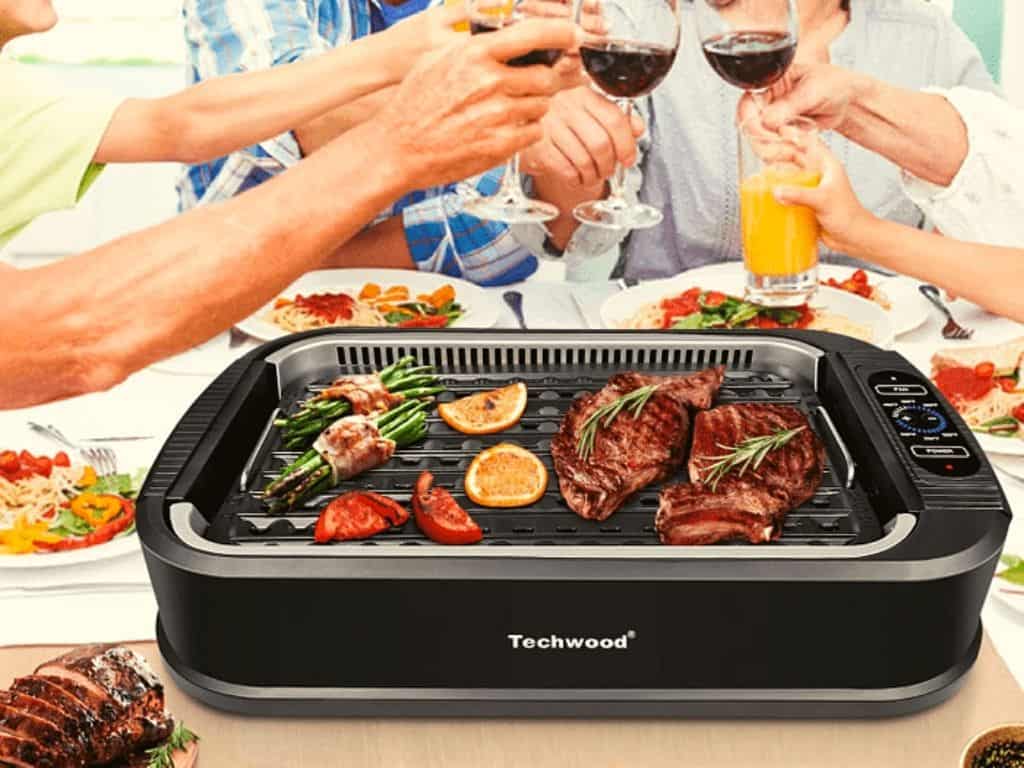
High Heat and Less Smoke: Electric grills also get very hot and have excellent heat control. They keep smoke at bay in various ways, but most often, this involves making sure their drippings drain away from the hottest part of the grill.
Easy to Use and Clean: To use the electric grill, it’s as simple as plugging it in. Non-stick coatings mean that you can use a minimum of oil in your cooking. They’re even a great way to cook messy and greasy foods like bacon since they drain drippings away. Clean-up is also usually easy with dishwasher-safe cooking grates and drip pans.
Lots of Options: The wide variety and the sheer number of diff,erent types of products make electric grills a great option for grilling indoors. They provide the most control over the grilling experience, and they allow you to mimic the same techniques you would use on a gas grill.
Check out our reviews of George Foreman grills for some affordable and easy-to-use options.
The downside of electric grills is that they take up counter and cabinet space, and some may balk at having yet another kitchen appliance.
Stovetop Grill Pans and Korean Grills
The most common type is a grill/griddle combo pan, usually made of trusty cast iron. Korean BBQ grills have a similar setup, but they have a unique design that looks like a UFO. Food cooks on a center ring, while drippings drain to a disk or a bowl below.
If you’re using a cast-iron model, season it properly, following the manufacturer’s instructions. Seasoning it in the oven might be the best bet since the grill design will not allow the oil to stay on the top of the grates where you need it most.

Saves Space: Compared to electric grills, buying a grill pan is a more space-conscious method for indoor grilling. The pan will go on your existing stovetop, or you could use a camp stove or hotplate.
Easy to Clean: Once you’re done cooking, cleanup is pretty straightforward. Clean like you do any other pan, remembering to use proper care with the cast iron, so you don’t lose its seasoning. Many Korean-style grill pans are non-stick and dishwasher-safe.
Using a grill pan is all about planning for the splatters. Clean off the rest of the stove, and place the pan over your favorite burner. Preheat the grill, and then apply a little bit of oil.
Cooking with these stovetop pans is often a little messier than the electric grills.
Electric grills are usually self-contained units designed to be used anywhere. They’ve got lids for capturing splatters, and their drippings are well contained.
On the other hand, stovetop pans are open-topped with no real way to control where the drippings go. The grill shape keeps the drippings off of the food, but where they go is another story.
Electric or Gas Flat Griddles
Griddles provide an alternative option for indoor grilling, but they represent a different form of cooking. Griddles don’t allow drippings to drain away, so using them resembles cooking in a non-stick or cast iron pan.
Griddles come in all sorts of designs, from Japanese teppanyaki grills, pan-style griddles to gas-powered portable ones designed for camp cooking. There are also electric counter-top griddles.
Some can be used in your kitchen or in the garage, and some cannot — this depends on the fuel and overall design.
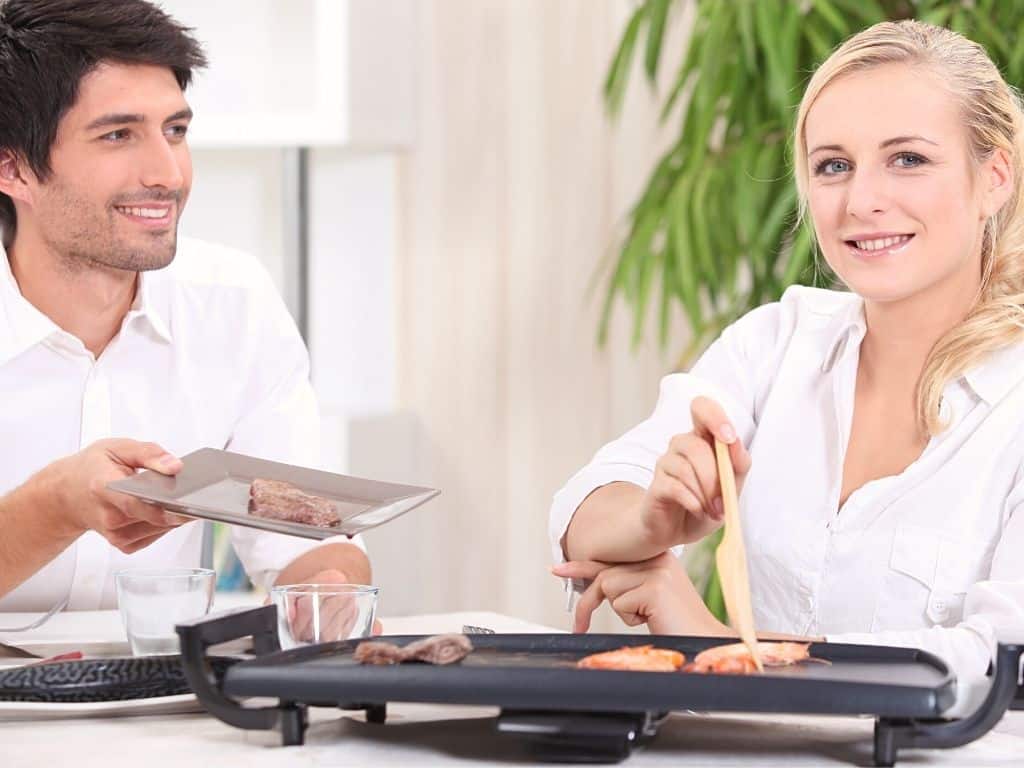
Versatile and Spacious: They can be used to cook pretty much anything, and the griddle shape means you can get much more cooking space for bigger parties than you can with your pans.
Cooking on a griddle isn’t complicated. And how much oil or fat you need to use to cook with will depend on how fatty the food you’re cooking is and how good the non-stick surface is.
As with grill pans, cast iron is one of the best choices, so long as it’s seasoned properly and cared for.
Broiler Ovens and Pans
I think that a broiler oven is one of the most underrated and underappreciated types of grills in the house.
A broiler pan is designed to mimic the grilling experience further. The pan elevates the food on a grate, with a drip catching pan below.
With a larger broiler and pan, you can cook quite a few burgers or steaks for your hungry troops quickly and easily. The trick is to keep an eye on it, keep moving it around, and don’t get it too close to the heat source.

Gets Very Hot: It gets hotter than pretty much any other heat source in the kitchen, and it’s probably something you already own.
Great for Big Items: There are few grilled dishes that the broiler can’t do as it can handle anything from skewers to whole chickens.
The most challenging part of using it is learning the best set up and keeping an eye on it. It’s hard to monitor and like a gas grill outside, it’s got hot spots and cooler spots. That means there’s a little bit of a learning curve.
You can also fine-tune it with the distance that you place foods away from the heat source. More delicate foods can be placed lower in the oven, meaning it’s more versatile than many other appliances.
Grilling in a Fireplace
If your home has a fireplace, you can use that as a heat source for cooking. Since ancient times, people have been cooking over open fires in their homes, so that’s no surprise. But with our modern kitchens and central heating, we turn to the fireplace for ambiance more than a cooking appliance.
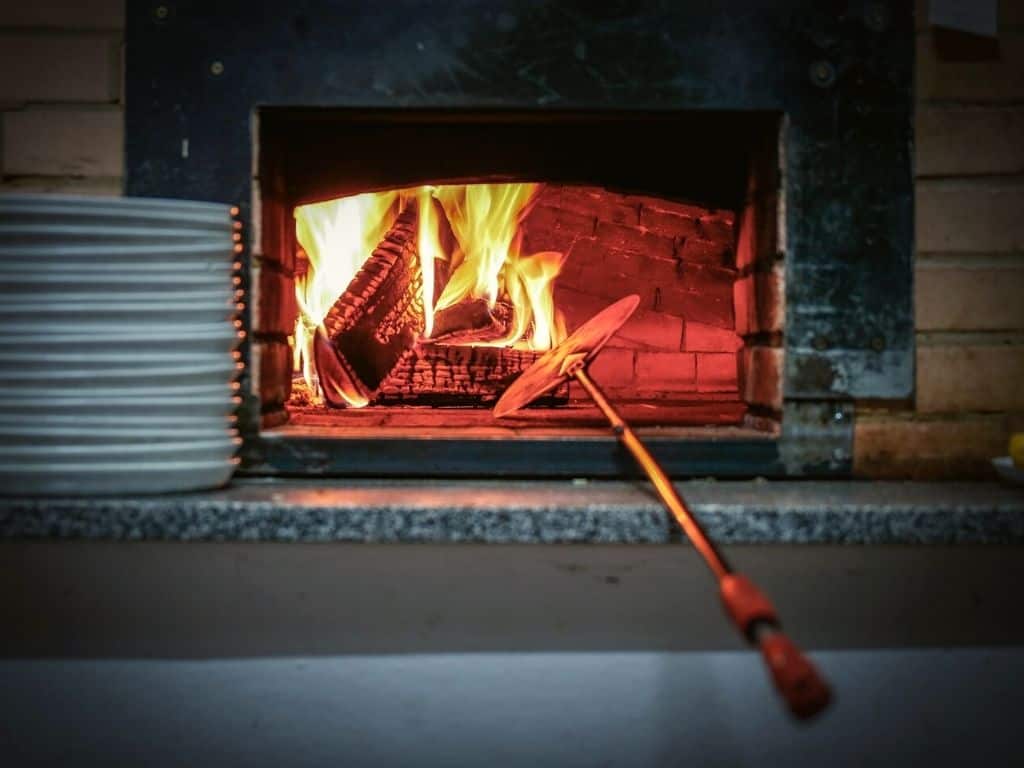
Smoky Flavor: The single most significant benefit to cooking over a wood fire is that it is the only indoor grilling method to produce real, flavorful smoke. It’s going to produce a lot of smoke, way more than even a charcoal grill outdoors would. That means smokey flavors, making this a real barbecue method.
Temperature Range: With the right tools, you can grill in temperatures ranging from 150 to 750 degrees or more.
You can get creative when cooking over a fire, and the exact setup will depend a little bit on the size and shape of your fireplace.
If you want to cook large pieces of meat, you could purchase or create a real rotisserie. You can cook smaller items on skewers, and some hardy foods can be cooked right on the embers.
Cast iron cookware can be used in the form of skillets or dutch ovens.
How to Get that Grilled Taste
If you’re used to grilling on gas, there’s nothing more you need to do when switching to an indoor grill. The flavors are going to be similar.
Also, choosing the right recipe makes a big difference. You can try one of the dishes recommended for indoor grilling by Taste of Home while some foods are better left for outdoor cooking.
Marinades and Sauces
Whatever marinades and sauces you use will work fine. When you want to up the smokey taste, you can choose barbecue sauces that have liquid smoke in them.
If you’re used to grilling on charcoal or using a smoker box extensively, you may want to up the smokey flavors slightly.
Liquid Smoke
Liquid smoke is the perfect product for taking it up a notch without access to real smoke. It’s an all-natural product that is created from the steam of wood-burning fires. It’s used in a wide range of products, from smoked cheeses to bacon, so even if you’ve never bought a bottle of it, you’ve likely consumed it.
To use liquid smoke, you just brush a small amount on the food as you would any other sauce. Or, if you’re making a marinade or sauce, add a few drops of liquid smoke into your recipe. It’s that simple, and it’s pretty tasty.
Indoor Grilling Safety
Any form of grilling requires very high heat sources, so it will require careful monitoring to keep your food from burning.
This certainly isn’t any different than grilling in your backyard, but inside your home, you have to worry about setting off smoke alarms and filling your house up with black, stinky smoke. If you’re in an apartment with an automated fire suppression system, you’ve got to be doubly careful to make no smoke at all.
Of the methods mentioned above, the trickiest one is using the broiler in your oven. There are a few reasons for this. It’s hard to keep an eye on the food because you have to bend down. It’s “out of sight, out of mind,” and for food on the grill, that’s not great.
There’s also no ventilation, so any smoke will come out of the front of your oven. Finally, it’s hotter than other cooking elements in your kitchen–things can go south quickly.
Countertop electric grills are probably the easiest to use. They feature smokeless designs that will minimize any flareups. It’s still a good idea, though, to keep them away from any combustible substances like paper and to keep them near your range hood for ventilation.
Conclusion
When you break down the definitions, grilling is, at its heart, just another form of applying heat to food. Like sautéing, braising, or roasting, it requires its own set of tools and the skills in using them.
But there is no reason that you have to always be outdoors to grill. There are many inexpensive ways that you can keep grilling year-round inside your kitchen.
